E-Commerce SEO
Table of Content
No online shop can grow without e-commerce SEO. Even though Paid and No Click Traffic strategies are becoming the default choices for digital marketing when diversifying the traffic sources, about 40% of all visitors still come to websites via the organic search results through search engines, such as Google, Bing, or Yahoo.
It takes some time until the results of a good search engine optimization become visible. Nevertheless, the success is sustainable and long-lasting. In combination with a sophisticated remarketing strategy with Google and Facebook Ads, there are many synergies to benefit from.
This article deals thoroughly with the topic of e-commerce SEO. It explains what to consider when choosing shop systems, what role the site architecture plays, and how to best proceed with technical and OnPage optimization. By reading this article you will gain knowledge about everything you need to know in order to start optimizing your online shop and to achieve a better ranking for organic search.
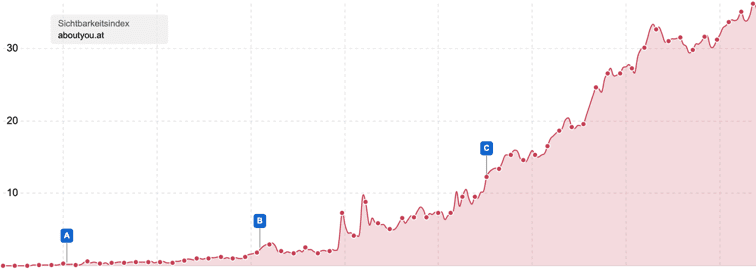 Development of the visibility of aboutyou.at
Development of the visibility of aboutyou.at
Shop systems & how you find the right one
E-commerce SEO starts with the choice of the shop system. Pay close attention to the following features :
- Meta Descriptions
- Title Tags
- Talking URLs
- Image Alt-Tags
- H1-Headings
- Meta-Robots-Settings
- Canonical URLs
- Links with anchor text in the navigation
- Integrated Content-Platform (for example a blog)
- Generation of sitemaps that can be individually configured
- Correct HTML header structure
- Creation of redirects
Large and widely used shop systems usually already encompass all features that are needed for search engine optimization, or alternatively, have options available for in-house developed SEO tools or by adding extensions via third-party plugins and out-of-the-box add-on sin-house. For example, shop systems with such features available are:
- Magento
- Shopify
- WooCommerce
- BigCommerce
- PrestaShop
Opting for one of the above-mentioned widely-used shop systems can be a huge advantage for your SEO endeavors as you gain access to a platform with a multitude of extendable options through plugins and add-ons.
You can also take a closer look at what the system has to offer from other well-known representatives. Sometimes the decisive difference lies in the details.
The right page architecture
Keyword research - key starting point for e-commerce SEO
Once you have your preferred shop system up and running, your next SEO step should be the keyword research. Keyword research will tell you for which keywords you should create pages to reach your target group. The best results are achieved with professional and paid tools. Free tools like Hypersuggest, Answerthepublic, or Google Ads Keyword Planner are a valuable addition and a useful starting point.
Take your time for this part and get professional help if you are not an SEO expert. After all, the results of the keyword research are the foundation on which you build your shop. The better and more extensive the research is, the stronger your foundation is. You will benefit from this for many years.
When assigning keywords you can be guided by the following.
- Homepage: The homepages of online shops usually rank best for your brand and for keywords like "menswear online shop".
- Category pages: Category sites play a central role in e-commerce SEO. It is important that they rank as prominently as possible for commercial keywords like "men's jeans" or "living room shelves".
- Product pages: Less important are product pages. After all, users rarely search for a specific product. However, there are exceptions to the rule.
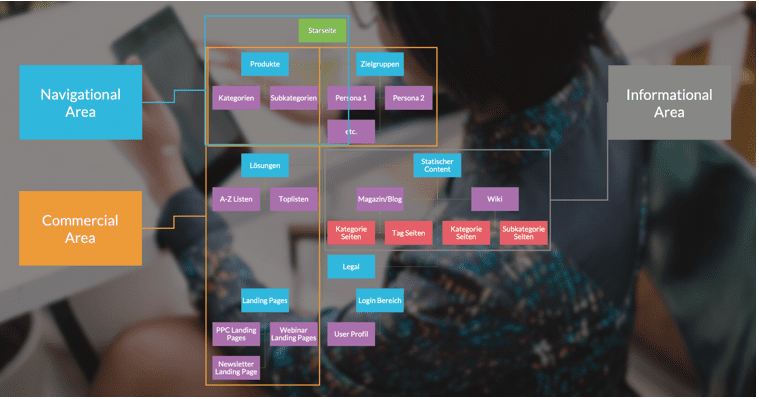 Correct planning of the page structure
Correct planning of the page structure
Short-tail keywords like "living room shelves" are very competitive. This is a problem that many online merchants face with webshop SEO. Small and/or still young online shops often have no chance to rank for such terms, because they are already "occupied" by the established companies in their branch.
Still, that is no reason to abandon all hope just yet. In fact, there are methods to get top rankings in the search results even as a small and young shop. One of the best methods is to supplement short-tail keywords with mid- or long-tail variants. One such long-tail keyword would be, for example, "buy solid wood living room shelves".
Here the market competition is usually much less saturated. Plus, there is also another advantage; long-tail keywords are more specific and the conversion rate is much higher.
A person who enters "living room shelves" in a search engine might just want to find out which shelves are available. With the search query "Buy solid wood living room shelves" you can assume a strong intention to buy. In this case, it is easier to turn the person into a customer - assuming you have some nice shelves, of course.
Important: Regularly check with suitable tools that each of your pages ranks for its own main keyword or set of similar keywords. Extensions or blog articles can quickly lead to several sub-pages competing for one keyword. The term for this is " keyword cannibalization " and the name itself already indicates that this is not a good thing.
In fact, keyword cannibalism causes fluctuations in search results and leads to a lower ranking. You can counteract this by, for example:
- strengthening the keyword on the page it should rank best while weakening it on the other pages.
- managing the internal link structure and by doing so grading up or down certain pages.
Page structure - logical for people and search engines
When designing the page structure you should keep two things in mind:
- Visitors should find their way around your digital store intuitively and find what they are looking for as quickly as possible
- A coherent architecture facilitates crawling by bots from search engines. This allows pages to be added, for example, to the index of Google more quickly.
In addition, a good page architecture increases the conversion rate. After all, potential customers in e-commerce are more likely to buy if they can find what they are looking for immediately. If they have to click back and forth for a long time, many of them drop out of the transaction being left frustrated.
The sentiments also play an important role. Customers like to come back to a well-organized, clear, and user-friendly webshop - a shop where they feel comfortable. This is also a critical factor in the field of webshop SEO.
Therefore, when creating pages, ask yourself questions like:
- How do users move through my site?
- How quickly do they get to individual products?
- Where can detours or superfluous clicks be avoided?
- Is it fun to navigate through my site?
- Do users always know immediately where they are on a page?
In general, a flat page architecture has proven itself to be the best strategy for online shops. Avoid having many subcategories and complex structures if you want to build a page with a flat page architecture. The more in-depth the site is, the higher the risk of dropouts.
So-called heatmap tools can be extremely helpful for search engine optimization for online shops. They show how users move through your shop and how they interact with it. Moreover, free tools like the Google Search Console are also helpful for the optimization of customer journeys and the behavioral flow of shop visitors.
 Developing true Google visibility in the Google Search Console
Developing true Google visibility in the Google Search Console
Tip: clever links can be used to shorten the journey. This is especially important for large online shops, where a flat architecture is difficult to realize.
Technical optimization
https instead of http – Security pays off
Nowadays using https is actually an industry standard. Nevertheless, one thing should not remain unmentioned; https is Google's favorite. Apart from that, the protocol shows users that you care about their security and make sure the connection is encrypted. Two good reasons to switch from http now in case you haven’t done it by now.
Avoid long loading times
The following applies to the loading time of web pages: the faster, the better. Long waiting is not only punished by Google and other search engines. It also increases the risk that users become annoyed and drop out. Conversely, short loading times ensure a positive user experience and better conversion rates.
But here is the catch - loading times of websites generally decrease as the technology advances. In turn, this also reduces the patience of your customers. For example, in the past, three or four seconds of loading time was quite common. Today, several seconds can seem like a relative eternity and many website visitors do not want to spend eternity waiting for your website to load.
The loading time of pages can be accelerated by the following measures, among others:
- Reduce the number of external sources that need to be loaded. This includes images and style sheets as well as scripts.
- Reduce the size of images. In a good image editing program, this can be done with a few clicks.
- Use a dedicated server instead of a shared hosting platform.
- If possible, use no or very few 301 redirects.
- Put all stylesheets into one CSS file. Link it from the section.
- Waiver of JavaScript documents and inline style specifications.
- Use a Content Delivery Network for international shops.
- Use DNS prefetching.
- Go for servers with http/2.
 Lighthouse Report to identify loading time problems
Lighthouse Report to identify loading time problems
Pagination - avoid ranking losses through noindex
Especially regarding category pages, it is often necessary to split them into several pages. In this context, SEO-savvy marketers speak of "pagination". This can be critical in order to succeed with online shop SEO.
Fortunately, you can prevent this problem. Use the noindex entry in the metatags to exclude pages from the search results.
The best way is to combine noindex with the follow attribute so that the crawler continues to follow the links on the page. By doing so, crawlers will not get lost on your page. Alternatively, there are other solutions for pagination, for example, the use of Canonical Tags. Each of these approaches has its advantages and disadvantages.
Prevent Duplicate Content using Canonical Tags
Especially in online shops, duplicate content quickly arises, which in turn leads to ranking losses. This is the case, for example, with:
- Filter functions
- Product variation, for example, different materials
- Subcategories, which appear in different upper categories
- Products with a similar description
This results in different URLs with the same or very similar content, for example: www.companyname.com/smartphones.html and
www.companyname.com/smartphones.html?Brand=Apple
In such cases, you can use Canonical Tags, either in the code or in the page response. This will show Google that one URL is the original content and the other is a version that the bot should ignore.
Caution: To make Canonical tags make sense, do not combine them with noindex and do not use more than one for a page. Also, make sure that the pages are in fact largely identical. Otherwise, there is a risk that the Googlebot will ignore the tag or even all of them on your page.
Mobile websites are a must-have
An ever-increasing number of users are shopping online via smartphones. For this reason, it is crucial to optimize your website for mobile devices. In addition, Google also rewards this behavior. Of course, short loading times are also important for mobile presentation.
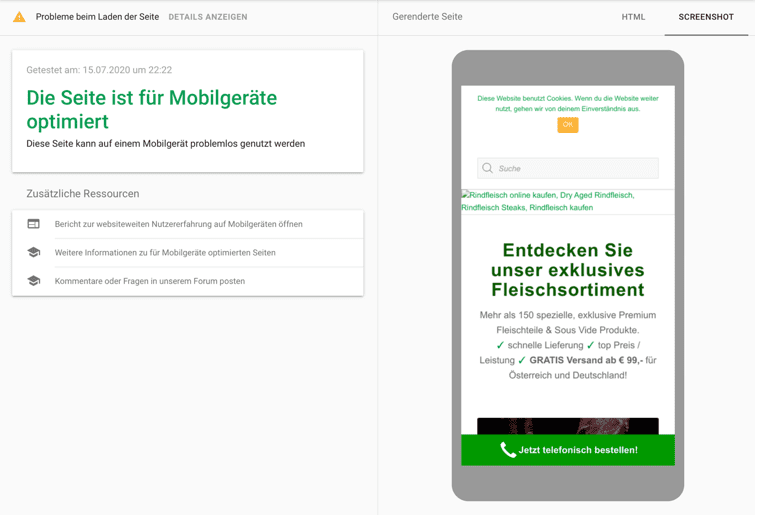 Mobile Friendly Testing Tool
Mobile Friendly Testing Tool
For international webshops - use hreflang
In international online shops, content exists in different languages. But how do you let Google know? The best way is to use the rel="alternate" hreflang="x" link attribute.
Used correctly, this attribute tells Google that certain URLs are intended for users with a particular language and should be displayed for them in search results.
In addition, by using hreflang you avoid that page versions are classified as duplicate content, which differs only in small things like regional spellings or currencies. Setting up such versions can be useful if you want to reach users who live in different regions but speak the same language.
However, the use of hreflang is not that simple. You can find detailed information in this article about hreflang.
Structured data - Rich snippets for more clicks
Structured data helps search engines to understand the content of your site more easily. They inform the crawler that the content is a video or that a sequence of numbers indicates opening hours, for example.
In addition, structured data produces search results with rich snippets, for example, customer ratings in the form of star ratings. Rich Snippets are highly attention-grabbing and encourage clicking. They are therefore an important element, especially in search engine optimization for online shops.
Take a look at this guide for markups to take advantage of structured data.
 Markup in the form of customer reviews
Markup in the form of customer reviews
OnPage optimization tips
The URL - short and clear
The URL of pages for itself can already have a significant impact in the field of webshop SEO.
To avoid unpleasant surprises, avoid having long and hard-to-read URLs with cryptic sequences of numbers and alphabetical soups.
Therefore:
- Keep your URLs short.
- Make your URLs comprehensible for people and search engines.
- Use talking URLs. They reveal at a glance what is to be found on the page.
In practice, this means:
www.onlineshop.com/menswear/sneaker instead of www.onlineshop.com/menswear/?p=4598
Metadata - tips for title and descriptions
The snippets in the search results are the first thing that your potential visitors see when they search for a keyword. If the first impression is good and on point, you have a much higher chance of persuading your potential visitors to click on your snippet and not one of your competitors provided.
To create perfect snippets, you should adjust the metadata for your page. With the help of a snippet generator, you can also fine-tune the length and how your metadata is shown in a snippet. The following tips will help you to create successful metadata:
Meta Title
- Integrate the main keyword as far in front as possible.
- Pay attention to the correct length of a maximum of 524 pixels, which corresponds to about 58-65 characters.
Meta Description
- Include the keyword and related terms.
- Use special characters for more attention.
- Follow the AIDA principle to pick up users.
- Include a Call to Action.
- Make sure that the correct length of about 100 - 145 characters is used.
 Optimal use of metadata for title and description
Optimal use of metadata for title and description
Text - an important addition to images
Do not neglect the text next to your pictures in your shop. After all, visitors cannot touch and try out products like in stationary retail.
Having excellently written descriptions on your page gives you the opportunity to provide valuable information about your products. As such, engaging and informative text is often a decisive factor for an order. To top things off, good text also provides important information to search engines and thus supports your e-commerce SEO endeavors.
That means above all:
- Write your own texts or have them written by a professional copywriter.
- Never copy manufacturer descriptions, even if it saves time and is free of costs.
- Integrate the central keyword into the H1 headline, body text, and alt tags.
- Use synonyms and related terms. For longer text an IDF*WDF analysis is worthwhile.
- Pack the most important properties of products on product pages in listings.
- Concentrate less on what products have or can have to offer. Instead, make clear what advantages the buyer has when using them- for example, looking attractive. Sell an experience, not a product. After all, that is what a purchase is all about.
- Make sure you have a tonality that fits your target audience and your brand and also use it consistently.
- For longer texts, emphasize clarity through subheadings, paragraphs, info boxes, and similar elements. Make skimming as easy as possible for visitors.
For category pages in online shops the following structure has proven to be useful:
- H1 heading with the main keyword.
- Short teaser also including the keyword.
- Products
- Longer text with additional (valuable) information, the main keyword, and other related terms.
Use filter function on your page and for product pages, we advise you to provide an internal link by displaying similar products.
As far as the length of the texts is concerned, there are many different opinions. However, we advise you to balance the length of the text with the essential information that you absolutely need to include for your visitors and for Google to get a good sense of your products.
Short and concise, but not too short is the best tactic. A bit of trial and error can't hurt here.
Important: The times of keyword spamming are over. Today Google punishes pages with long and meaningless texts full of keywords.
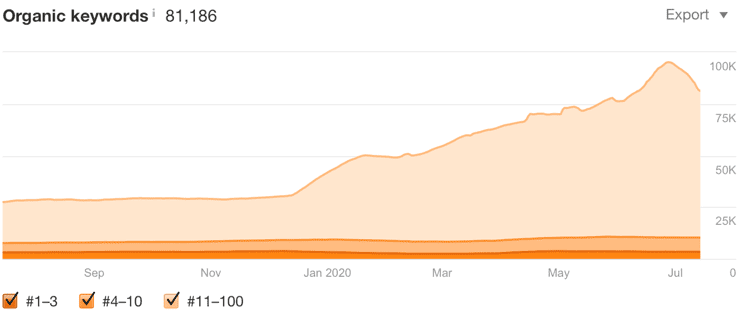 Keyword development for organic rankings
Keyword development for organic rankings
Internal and external link building
Implementing internal links correctly
With the help of meaningful internal links, Google is able to get a picture of your website and what content is important. Here, the emphasis is on the word meaningful:
- Do not link too much on one page. Two links per 500 words are sufficient.
- Pay attention to clear and meaningful anchor texts instead of using "here".
- Do not link the same destination more than once on the same page.
- Always think about the users or customers. Internal links should help them to reach their goal quickly.
External links - receive valuable backlinks
Performing good in regard to external linking is more difficult than internal linking. Yet, good backlinks support a good ranking.
The catch: Many common strategies to actively obtain backlinks are punished by Google. You should definitely do without:
- Link swapping
- Link buying via respective portals
Even in forums or comment functions, leaving meaningless comments like "great article" to create backlinks is a questionable method. It is quickly noticed by the respective operator, is not appreciated, and leads to your comment not being approved.
So what are the recommended methods to get good backlinks for webshop SEO?
- Directories: Ask for your site to be listed in Storefinder and similar directories.
- Guest articles: Attempts to place guest articles in thematically relevant portals.
- Reviews: Especially small bloggers are happy about test products and will gladly review your products. But make sure that it is a serious blog that has something to do with the topic of your online shop.
- Valuable Content: One of the best ways to get backlinks is to provide valuable content. In the best-case scenario, increased organic traffic will then create backlinks automatically.
It is also important to check the existing backlinks regularly. If these lead nowhere, for example, because a page no longer exists, this can have a negative impact on the ranking and make a bad impression on visitors.
 Natural backlink development over the years
Natural backlink development over the years
Content marketing - good content for good rankings
Why does it make sense to have a blog when you actually want to sell products?
The main reasons are:
- Search requests with a clear intention to buy (commercial) are in the minority. Most people want to know and learn something first. They have a problem they want to solve. To use these keywords (informational) you need guides like "What is the difference between different types of mattresses" or "10 tips for choosing the best shop system". Ideally, this will create an intention to buy and draw attention to your products.
- Good content is perfectly suited to generate backlinks and thus support search engine optimization for online shops
- By linking from content to product or category pages, you can add value to them.
It is therefore worthwhile for online shops to publish a blog or even their own online magazine, create infographics, and provide answers to relevant questions.
Caution: Only good content is king. Sloppy and hurried lists with meaningless graphics have the opposite effect.
Online Shop SEO thrives on constant optimization
Your shop is ranking well and sales are growing? Congratulations! But don't make the mistake now of leaning back and doing nothing. Great e-commerce SEO is built on an active maintenance and constant re-optimizations.
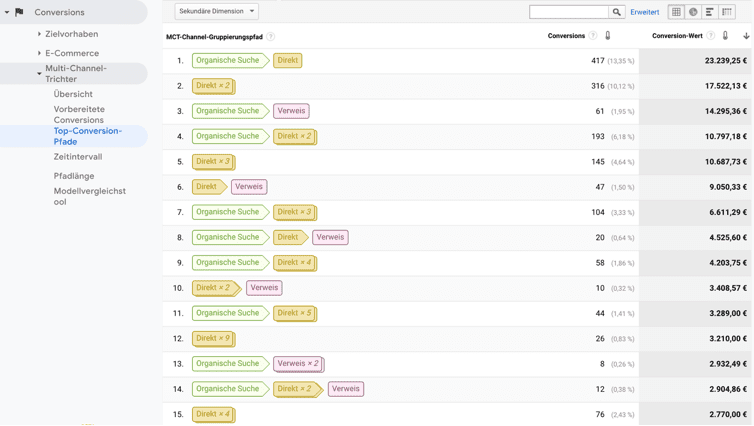 Organic search with good SEO performance is one of the best conversion channels
Organic search with good SEO performance is one of the best conversion channels
After all, in many shops, new products and categories are added from time to time. Also, the algorithm of Google and other search engines change over time. In addition, the user experience can always be improved even with successful shops. With the tips in this article, you'll be in a good position to secure a good ranking for your site in the long run.
 |
About the authorFlorian Hieß is a passionate online marketer and has more than 15 years of experience in online marketing with a focus on SEO and performance marketing in eCommerce and SaaS. He is Head of Digital Marketing at the social media management tool Swat.io and also works as a lecturer for search engine optimization at the FH St.Pölten und Donau Uni Krems. Together with his wife and business partner Romana, he supports medium-sized companies in online marketing. |